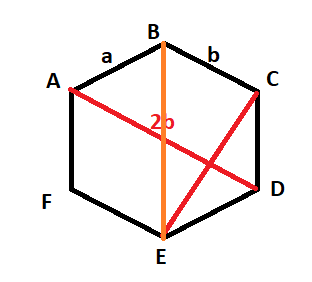
If $ABCDEF$ is a regular hexagon with $AB = \vec a$ and $BC = \vec b$ then $CE$ equals :
A.$\vec b - \vec a$
B.\[ - \vec b\]
C.\[\vec b - 2\vec a\]
D.None of these
Answer
442.8k+ views
Hint: This question utilises the laws of vector addition and multiple properties of vectors that need to be remembered to solve this question. We approach or begin this question by marking the vectors on a regular hexagon and solve for different sides until we get the diagonal that the question is asking for. We will need to remember the properties of the isosceles triangle that is a part of a regular hexagon.
Complete step by step solution:

In the question, two vectors have been given. They are both adjacent vectors, that is
$AB = \vec a$ and $BC = \vec b$ .
The question asks for the body diagonal that passes through B and E.
That is, $CE = ?$
We can see that $ABCD$ is part of an equilateral triangle with $AD$ as the base and $BC$ passing through the midpoints of the other two sides. This property gives the conclusion that the base is twice the length of the line passing through the midpoints of the sides.
Therefore,
$AD = 2\vec b$
Using the laws of vector addition of a polygon,
\[AD = AB + BC + CD\]
\[ \Rightarrow 2\vec b = \vec a + \vec b + CD\]
\[CD = \vec b - \vec a\]
Since $BE$ is twice the length as $CD$ and has same directions, that is parallel direction, therefore,
$BE = 2CD$
$ \Rightarrow BE = 2\vec b - 2\vec a$
Again using triangle law of vector addition,
$BE = BC + CE$
$CE = BE - BC = 2\vec b - 2\vec a - b$
$ \Rightarrow CE = \vec b - 2\vec a$
Therefore the correct option for this question is $\left( c \right)\vec b - 2\vec a$
Note:
This question has multiple ways to solve it since any amount can be solved before we get the vector we require. Many sides can all be clubbed together and many diagonals can be calculated simply to get the diagonal we need. It’s all about solving the question in as few steps as possible to make it fast and avoid any silly mistakes.
Complete step by step solution:

In the question, two vectors have been given. They are both adjacent vectors, that is
$AB = \vec a$ and $BC = \vec b$ .
The question asks for the body diagonal that passes through B and E.
That is, $CE = ?$
We can see that $ABCD$ is part of an equilateral triangle with $AD$ as the base and $BC$ passing through the midpoints of the other two sides. This property gives the conclusion that the base is twice the length of the line passing through the midpoints of the sides.
Therefore,
$AD = 2\vec b$
Using the laws of vector addition of a polygon,
\[AD = AB + BC + CD\]
\[ \Rightarrow 2\vec b = \vec a + \vec b + CD\]
\[CD = \vec b - \vec a\]
Since $BE$ is twice the length as $CD$ and has same directions, that is parallel direction, therefore,
$BE = 2CD$
$ \Rightarrow BE = 2\vec b - 2\vec a$
Again using triangle law of vector addition,
$BE = BC + CE$
$CE = BE - BC = 2\vec b - 2\vec a - b$
$ \Rightarrow CE = \vec b - 2\vec a$
Therefore the correct option for this question is $\left( c \right)\vec b - 2\vec a$
Note:
This question has multiple ways to solve it since any amount can be solved before we get the vector we require. Many sides can all be clubbed together and many diagonals can be calculated simply to get the diagonal we need. It’s all about solving the question in as few steps as possible to make it fast and avoid any silly mistakes.
Recently Updated Pages
Master Class 11 Accountancy: Engaging Questions & Answers for Success

Glucose when reduced with HI and red Phosphorus gives class 11 chemistry CBSE

The highest possible oxidation states of Uranium and class 11 chemistry CBSE

Find the value of x if the mode of the following data class 11 maths CBSE

Which of the following can be used in the Friedel Crafts class 11 chemistry CBSE

A sphere of mass 40 kg is attracted by a second sphere class 11 physics CBSE

Trending doubts
Define least count of vernier callipers How do you class 11 physics CBSE

The combining capacity of an element is known as i class 11 chemistry CBSE

Proton was discovered by A Thomson B Rutherford C Chadwick class 11 chemistry CBSE

Find the image of the point 38 about the line x+3y class 11 maths CBSE

Can anyone list 10 advantages and disadvantages of friction

Distinguish between Mitosis and Meiosis class 11 biology CBSE




